The Peace Lily, known scientifically as Spathiphyllum, is a beloved houseplant cherished for its elegant appearance and air-purifying qualities.
Recognizable by its glossy green leaves and white, sail-like flowers, it’s a popular choice for both homes and offices. Beyond its visual appeal, the Peace Lily is remarkably easy to care for, making it ideal for both novice and experienced plant enthusiasts.
In this article, we’ll explore how to grow and nurture these beautiful plants, ensuring they thrive and bring a touch of tranquility to your space.
Benefits of Growing Peace Lily
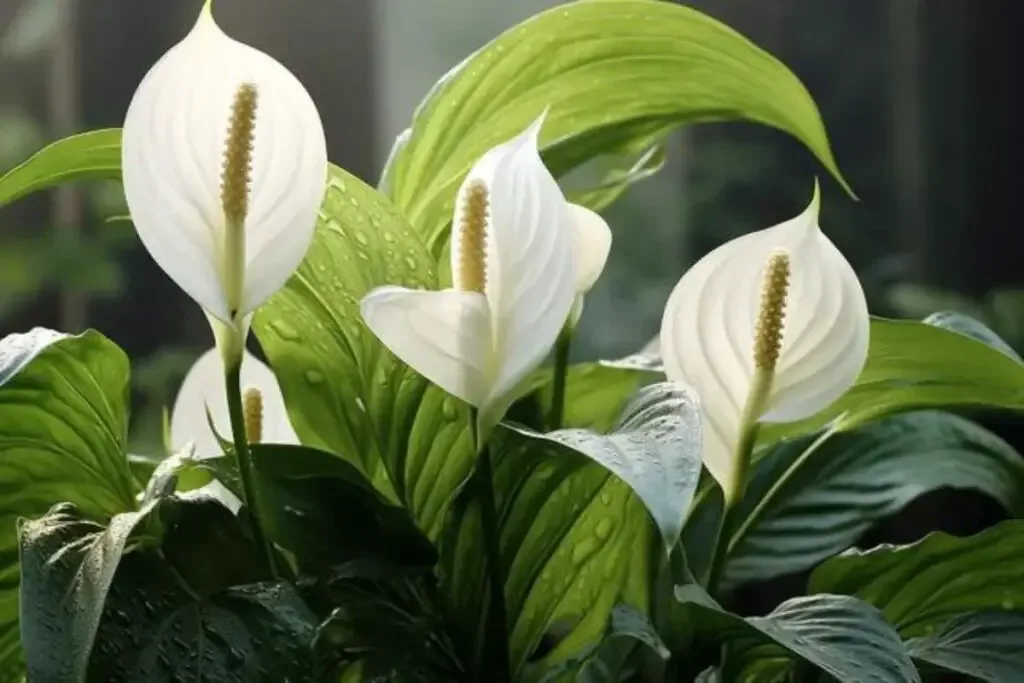
1. Air Purification
One of the most celebrated benefits of the Peace Lily is its ability to purify indoor air. It’s known for removing toxins such as benzene, formaldehyde, and trichloroethylene from the environment, making it a healthy addition to any indoor space.
2. Low Light Tolerance
Peace Lilies are well-suited for indoor environments with low to moderate light, making them ideal for spaces where other plants might struggle to thrive.
3. Ease of Care
These plants are known for their hardiness and are forgiving of occasional over- or under-watering. Their ability to signal when they need water (their leaves droop noticeably) makes them particularly easy for beginners to care for.
My Favorite Peace Lily Varieties
There are several varieties of Peace Lily, each with its unique characteristics. From compact varieties perfect for small spaces to larger ones that make a dramatic statement, there’s a Peace Lily for every preference.
Here are three varieties that I find particularly appealing:
1. Spathiphyllum ‘Mauna Loa’
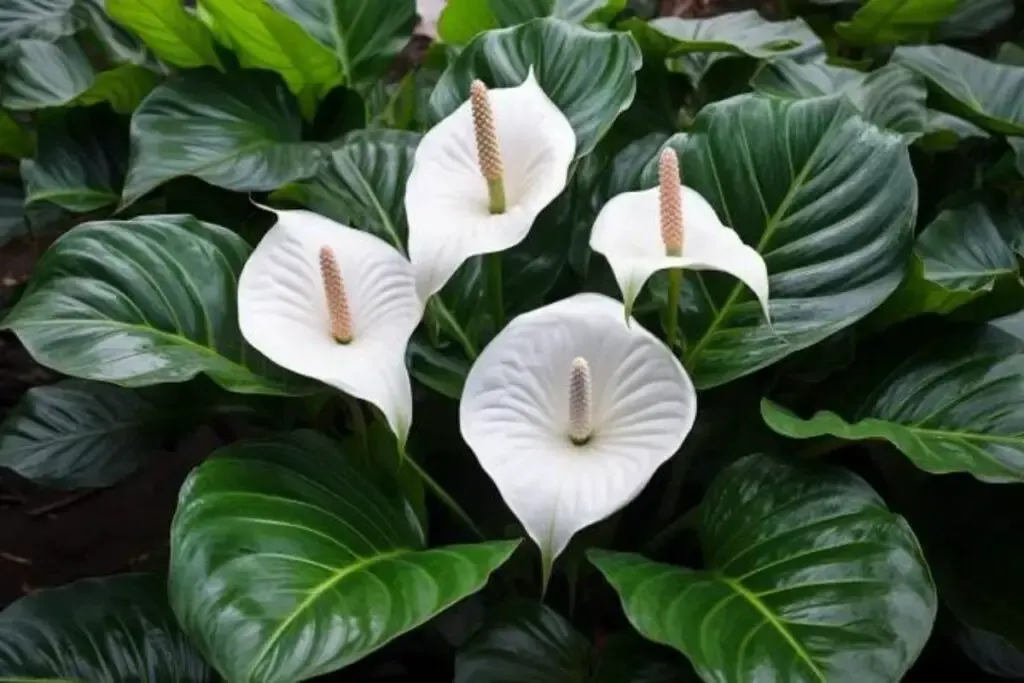
Named after the Hawaiian volcano, ‘Mauna Loa’ is known for its large, glossy leaves and impressive blooms. It’s a larger variety, making it a striking focal point in any room.
2. Spathiphyllum ‘Domino’
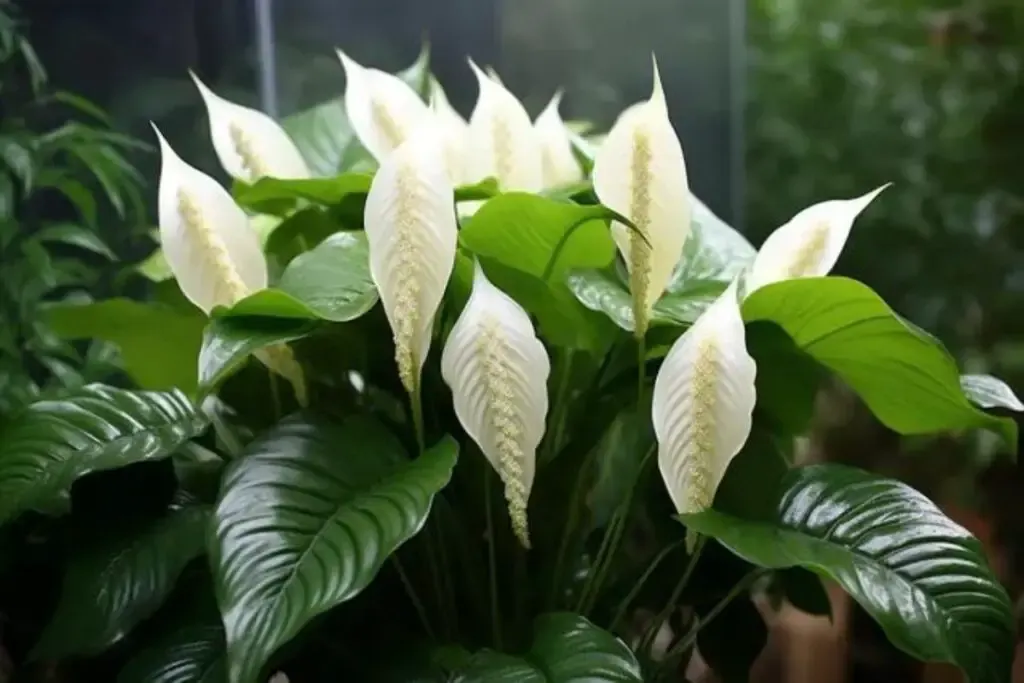
This variety stands out with its variegated leaves, offering a different look to the standard green. The white and green speckled leaves add a decorative twist to the usual Peace Lily appearance.
3. Spathiphyllum ‘Petite’
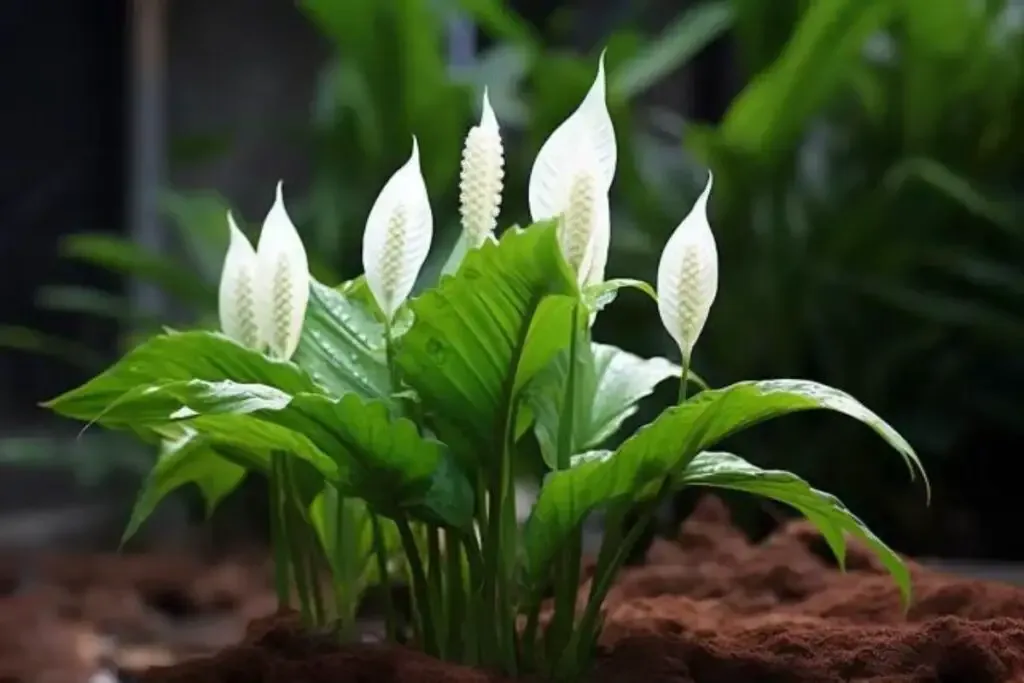
As the name suggests, this is a smaller variety, perfect for desks or small tables. It offers all the benefits of a Peace Lily in a compact size.
Peace Lily Care
Caring for a Peace Lily is a rewarding experience that enhances any indoor space with its elegant foliage and flowers.
These plants are not just beautiful but also forgiving, making them suitable for gardeners of all levels. Let’s dive into the essentials of Peace Lily care to ensure your plant remains healthy and vibrant.
Planting

When planting a Peace Lily, choose a pot with drainage holes to prevent waterlogging. Use a well-draining, rich potting mix to provide the right nutrients and support.
The pot should be slightly larger than the root ball to allow room for growth.
Light
Peace Lilies prefer bright, indirect light but can tolerate lower light conditions. Avoid direct sunlight, which can scorch their leaves. A spot near a window with a sheer curtain is ideal for filtering light.
Soil
A well-draining, loamy potting mix is best for Peace Lilies. You can create a suitable mix using equal parts of peat, perlite, and organic compost.
This combination ensures good drainage and aeration while retaining enough moisture.
Water
Watering is crucial for Peace Lilies. They like their soil to be consistently moist but not soggy. Allow the top inch of soil to dry out before watering again. Peace Lilies will droop when thirsty, making it easy to know when it’s time to water.
Temperature and Humidity
Peace Lilies thrive in warm, humid environments typical of their native tropical rainforests. Aim for temperatures between 65-75°F (18-24°C) and avoid sudden temperature changes.
They also appreciate higher humidity, which can be achieved with a humidifier or a pebble tray.
Fertilizer
Feed your Peace Lily with a balanced, water-soluble houseplant fertilizer every 6-8 weeks during the growing season (spring and summer). Reduce feeding in the fall and winter when the plant’s growth naturally slows down.
Pruning
Pruning a Peace Lily is a simple yet important aspect of its care. Regular pruning not only keeps the plant looking neat but also encourages healthier growth and flowering. Here are three key pruning tips:
- Remove Yellow or Brown Leaves: Regularly trim off any yellowing or brown leaves at the base to keep your plant looking fresh and healthy.
- Deadhead Spent Flowers: Once the flower fades, cut it off near the base of the flower stem. This encourages the plant to produce more blooms.
- Shape the Plant: If your Peace Lily is getting too large or leggy, you can prune it back to maintain the desired size and shape.
Propagating
Propagating a Peace Lily is relatively straightforward and is usually done by division:
- Division: Gently remove the plant from its pot and separate the root ball into smaller sections, each with several leaves and roots.
- Repotting: Plant each division in its own pot with fresh, well-draining potting mix. Water them well and place them in a warm, humid environment with indirect light.
This method is best done in the spring and is a great way to multiply your Peace Lilies or share them with friends.
How to Grow Peace Lily From Seed
Growing Peace Lilies from seed is less common and more challenging than propagation by division. If you wish to try:
- Collect Seeds: After the flower fades, seeds can be collected from the plant, although they are rarely produced in indoor conditions.
- Sowing: Plant the seeds in a well-draining seed-starting mix, keeping the soil consistently moist and warm.
- Germination: With patience and the right conditions, the seeds will eventually germinate, but this process can be lengthy and uncertain.
Growing in Pots
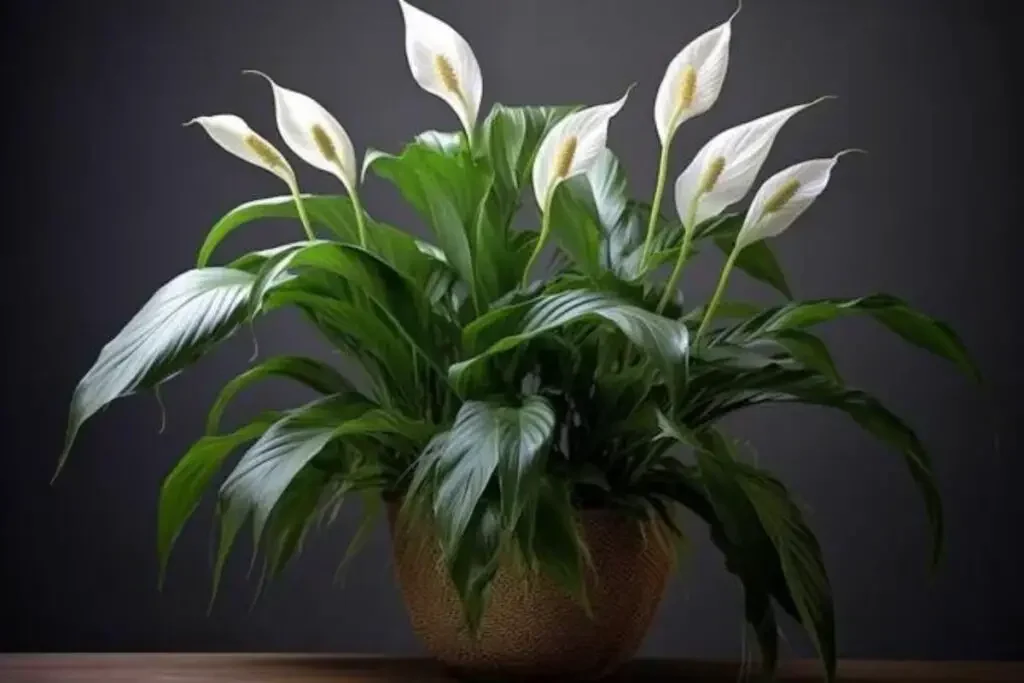
Peace Lilies are well-suited to pot culture and are commonly grown as indoor potted plants:
- Choosing the Right Pot: Ensure the pot has drainage holes and is appropriately sized for the plant. Peace Lilies prefer to be slightly root-bound.
- Potting Mix: Use a well-draining, rich potting mix to provide the necessary nutrients and moisture retention.
- Care: Provide consistent moisture, indirect light, and regular feeding during the growing season. Repot every couple of years or when the plant becomes too crowded in its pot.
Overwintering
Peace Lilies are tropical plants and don’t tolerate cold temperatures well. Overwintering them properly is key to ensuring they stay healthy throughout the year.
Keep your Peace Lily in a warm room away from cold drafts and heating vents. Reduce watering in the winter months, but make sure the soil doesn’t completely dry out.
This period of reduced growth is natural, so don’t be alarmed if your plant isn’t as vibrant as it is in the warmer months.
Transplanting
Transplanting a Peace Lily can help rejuvenate an overcrowded plant and give it more space to grow. The best time to transplant is in the spring:
- Choose a Larger Pot: Select a new pot that is slightly larger than the current one.
- Repotting: Carefully remove the plant from its old pot and place it in the new one with fresh potting soil.
- Aftercare: Water the plant well after repotting and place it in a location with indirect sunlight. Avoid fertilizing immediately after repotting to allow the plant to settle in its new environment.
Common Pests & Diseases
Peace Lilies are relatively hardy but can occasionally suffer from pests and diseases:
- Mealybugs and Spider Mites: These pests can be managed with insecticidal soap or neem oil.
- Root Rot: Caused by overwatering, ensuring good drainage and not letting the plant sit in water can prevent this.
- Leaf Spot: This can be caused by fungal or bacterial infections. Improving air circulation and reducing leaf wetness can help control this issue.
Growing and caring for a Peace Lily is a fulfilling endeavor that brings elegance and a breath of fresh air to any indoor space.
These plants are not just decorative; they’re also practical, easy to care for, and adaptable to various indoor environments.
With the right care, your Peace Lily will be a long-lasting and serene addition to your home or office. Happy gardening!

